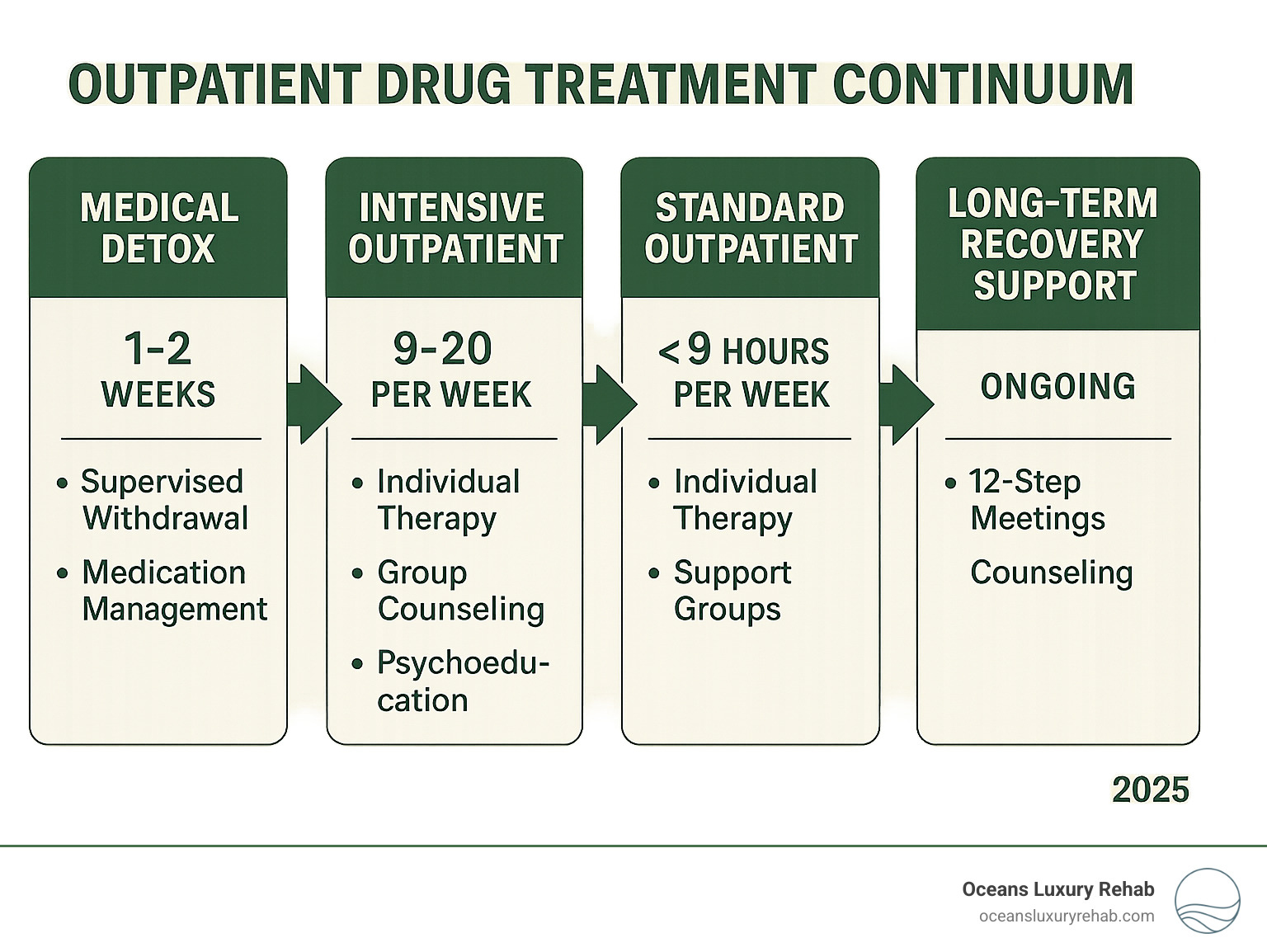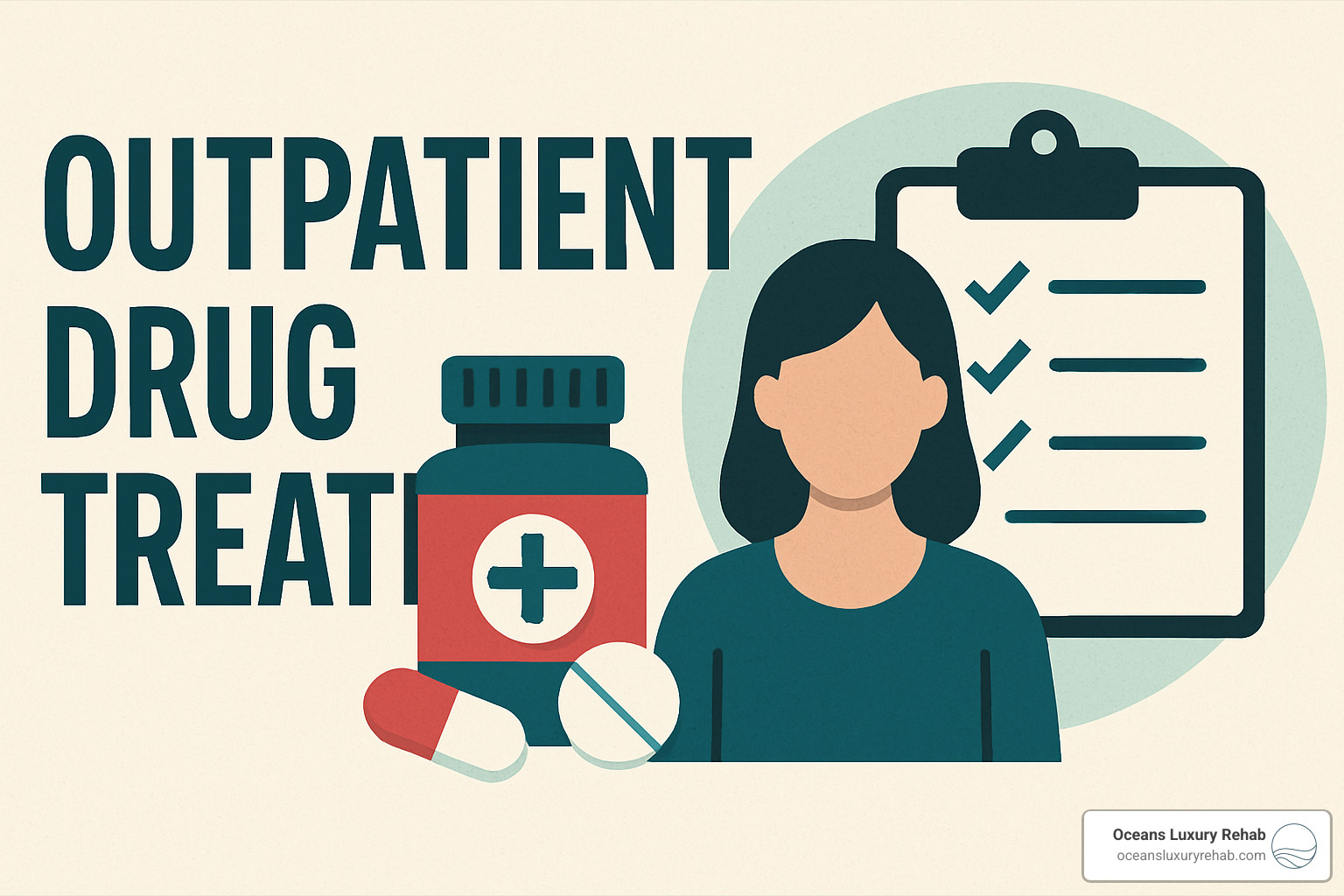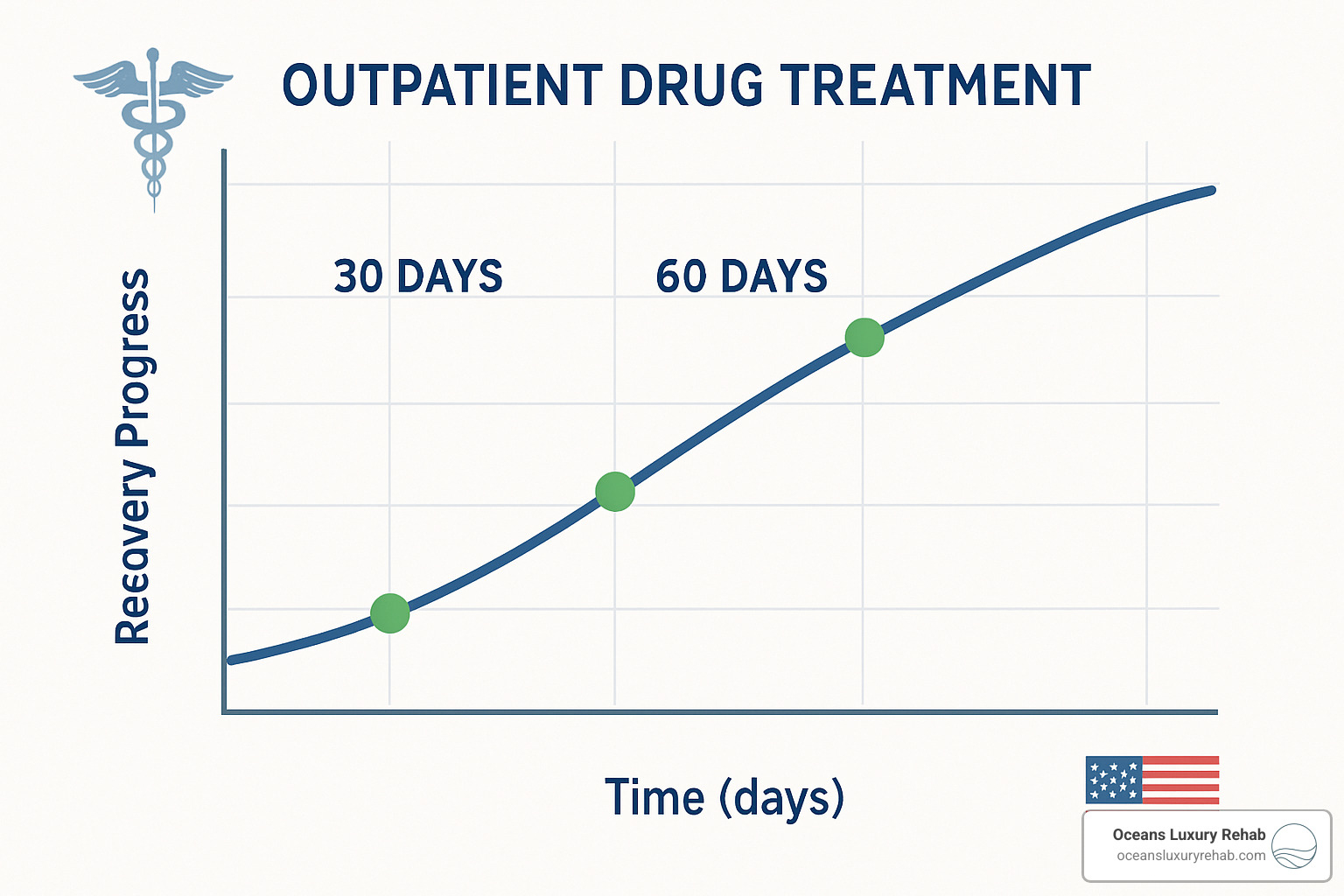Why Outpatient Drug Treatment is Changing Recovery
Outpatient drug treatment allows you to receive professional addiction care while living at home and maintaining your daily responsibilities. Unlike inpatient programs that require 24/7 facility stays, outpatient treatment offers scheduled therapy sessions that fit around your work, family, and personal commitments.
Key facts about outpatient drug treatment:
- Flexibility: Live at home while attending 1-20+ hours of treatment per week
- Cost: Typically $2,000-$5,500 for 1-3 months vs. $20,000-$30,000 for inpatient care
- Effectiveness: 83% of patients report no or low cravings one year after treatment
- Duration: Minimum 90 days recommended for best outcomes
- Coverage: Most insurance plans cover outpatient services under ACA provisions
Three main levels of outpatient care:
- Standard Outpatient – Less than 9 hours per week
- Intensive Outpatient Program (IOP) – 9-20 hours per week
- Partial Hospitalization Program (PHP) – 20+ hours per week
Outpatient treatment works best for people with mild to moderate substance use disorders who have a strong support system and motivation to recover. It combines evidence-based therapies like cognitive behavioral therapy (CBT), group counseling, and medication-assisted treatment (MAT) in a flexible format.
The beauty of outpatient care lies in its real-world application – patients can apply skills learned in therapy immediately in their home environment rather than waiting to transition from a residential facility back to daily life.
I’m Clint Kreider, and I’ve spent over 5 years working directly in drug and alcohol treatment, helping clients steer outpatient drug treatment options that fit their unique circumstances.

Learn more about outpatient drug treatment:
Outpatient Drug Treatment 101: Levels, Services, Effectiveness
How Outpatient Differs from Inpatient & Who It Helps
The biggest difference between outpatient drug treatment and inpatient care is where you sleep at night. With outpatient treatment, you go home after therapy sessions. With inpatient care, you live at the treatment facility around the clock.
This fundamental difference shapes your recovery experience. In outpatient treatment, you’re practicing new coping skills in the real world from day one, dealing with the same triggers and stressors that contributed to your addiction while having professional support.
Outpatient drug treatment works best for people with mild to moderate substance use disorders who have a strong foundation. If you have supportive family, stable housing, and genuine motivation to change, outpatient care can be incredibly effective. It’s also ideal if you need to keep working, caring for children, or attending school while getting help.
The American Society of Addiction Medicine uses ASAM criteria to determine who’s a good fit for outpatient treatment, looking at withdrawal severity, medical complications, readiness to change, and home environment.

Outpatient treatment works particularly well for professionals who can’t take months off work, parents who need to stay home with kids, and students continuing education. The flexibility of maintaining your routine while getting treatment can strengthen recovery by keeping you connected to positive parts of your life.
The cost savings are significant – often five to ten times less expensive than inpatient care. You get to practice recovery skills in your actual environment rather than in a controlled facility, with no jarring transition from treatment back to real life.
Program Levels & Core Therapies
Outpatient drug treatment comes in three main intensities, designed for different recovery stages and need levels.
Standard outpatient treatment requires less than 9 hours per week, usually one or two therapy sessions. This works well for people who’ve completed intensive treatment or those with less severe addictions.
Intensive Outpatient Programs (IOP) involve 9-20 hours per week, typically three to four days with sessions lasting three to four hours each. This is the sweet spot – intensive enough for structure and support, flexible enough to maintain responsibilities.
Partial Hospitalization Programs (PHP) are the most intensive at 20+ hours per week, five to seven days for four to six hours daily. This provides nearly inpatient-level intensity while letting you sleep at home.
| Program Level | Hours/Week | Typical Duration | Best For |
|---|---|---|---|
| Standard OP | 1-8 | 6-12 months | Continuing care, maintenance |
| IOP | 9-20 | 3-6 months | Step-down from inpatient, primary treatment |
| PHP | 20+ | 2-4 months | Alternative to inpatient, medical monitoring needed |
Core therapies include Cognitive Behavioral Therapy (CBT) to identify and change thought patterns leading to substance use. Group therapy connects you with others who understand your struggle. Medication-Assisted Treatment (MAT) combines FDA-approved medications with counseling for opioid and alcohol disorders.
Family therapy addresses how addiction affects the entire family system, teaching communication skills and repairing relationships. Case management coordinates care and connects you with community resources. Peer support provides hope through counselors in recovery.
Scientific research on intensive outpatient treatment shows comprehensive programs addressing multiple addiction aspects produce the best outcomes.
Benefits, Risks & Success Rates
Outpatient drug treatment offers compelling advantages. The cost savings make recovery accessible – $2,000-$5,500 versus $20,000-$30,000 for inpatient care. The flexibility keeps you connected to positive life aspects while getting professional help.

You get real-world practice with recovery skills from day one, practicing new strategies immediately in your living situation. Family integration happens naturally with ongoing involvement leading to stronger relationships.
Research shows 83% of patients report no or low cravings one year after treatment. When lasting three months or longer, outpatient programs can be as effective as inpatient care.
Challenges include exposure to environmental triggers and less structured environments requiring more self-discipline. Some people have complex medical needs requiring monitoring outpatient settings can’t provide.
Success depends on duration (minimum 90 days), regular attendance, support systems, motivation, stable housing, and meaningful daily activities. Studies show people completing at least 90 days have significantly lower relapse rates.
Starting & Thriving in an Outpatient Plan
Getting Started: Assessment, Costs & Insurance Options in Outpatient Drug Treatment
Starting outpatient drug treatment begins with a comprehensive clinical evaluation to understand your unique situation and create an effective treatment plan.
The assessment process reviews your medical history, substance use history, and mental health conditions like depression or anxiety that often accompany addiction. We evaluate your social support system – family relationships, living situation, and work commitments – and assess your motivation and readiness for change.
Based on this evaluation, we create an individualized treatment plan including specific therapies, medication recommendations, session schedules, family involvement strategies, and continuing care planning.
Cost breakdown: Standard outpatient sessions run $100-$300 per session, intensive outpatient programs cost $250-$350 per day, and partial hospitalization programs cost $350-$450 per day. Complete programs lasting 1-3 months total $2,000-$5,500 compared to $20,000-$30,000 for inpatient care.
Insurance coverage is comprehensive. Medicare covers intensive outpatient programs for people needing at least 9 hours weekly. Medicaid coverage varies by state but most cover outpatient substance abuse treatment. Private insurance under the Affordable Care Act covers mental health and substance use services like other medical needs.
Most treatment centers offer sliding scale fees, payment plans, and information about government grants. Check Scientific research on coverage options to verify your benefits.
If considering detox first, learn about outpatient detox options providing medical supervision while returning home daily.
Staying on Track & Next Steps: Family Support, Progress Markers, Continuing Care
Success in outpatient drug treatment requires ongoing commitment, clear progress markers, and strong support systems.
Setting S.M.A.R.T. goals – Specific, Measurable, Achievable, Relevant, Time-bound – makes the difference. Instead of “I want to get better,” set goals like “I will attend all therapy sessions this month.”
Progress tracking uses regular urine screens, craving scales, mood assessments, and functional assessments for work and relationships. Recovery milestones include establishing stability at 30 days, developing coping skills at 60 days, forming healthy habits at 90 days, and long-term planning at 6 months.

Family involvement significantly improves outcomes. Family members provide emotional support, help identify triggers, and participate in therapy to improve communication patterns. Family therapy addresses enabling behaviors, establishes healthy boundaries, rebuilds trust, and teaches stress management.
Continuing care is essential for long-term sobriety. Options include alumni programs for ongoing peer support, twelve-step programs like AA and NA, booster sessions for skill reinforcement, sober living environments for transitional housing, and community resources for employment and education support.

Relapse prevention involves identifying personal triggers, developing healthy coping skills, building support networks, creating daily structure, and planning for challenging situations. Warning signs include increased cravings, skipping sessions, relationship conflicts, sleep disturbances, and isolation.
At Oceans Luxury Rehab, our comprehensive outpatient rehab programs in Orange County provide flexibility and ongoing support for sustainable recovery while maintaining daily responsibilities.
Every day you choose recovery is a victory. With the right support system, treatment plan, and personal commitment, outpatient drug treatment provides the foundation for a fulfilling, substance-free life. Recovery is possible, and you don’t have to do it alone.
